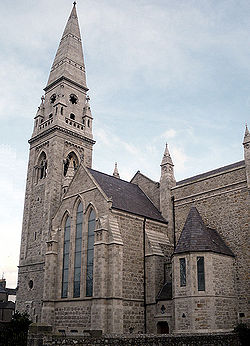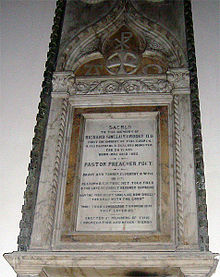- Mariners' Church, Dún Laoghaire
-
Coordinates: 53°17′32″N 6°7′55.4″W / 53.29222°N 6.132056°W
Mariners' Church Protestant Episcopal Mariners' Church 
Location Haigh Terrace, Dún Laoghaire Country Ireland Denomination Church of Ireland History Founded 1836 Architecture Architect(s) Joseph Welland Completed 1837 Closed 1971 Specifications Length 35.5 metres Width 16.3 metres Nave width 29.8 metres Height 18 metres The Mariners' Church is a former Church of Ireland church located in Haigh Terrace, near the centre of Dún Laoghaire town, southeast of Dublin city. It now houses the National Maritime Museum of Ireland.
History
The church was built by subscription in 1836, in pursuance of a donation of £1000 for its endowment, for seafarers as the "Protestant Episcopal Mariners' Church at Kingstown Harbour".[1] Due to the increasing importance of Kingstown (as the town was then known) and its harbour, it was considered necessary to have a Church to look after the spiritual needs of officers and sailors. The church, designed by the architect Joseph Welland (1798-1860), was opened in 1837. This initial build consisted of just the nave and transepts. Richard Brooke, the first chaplain, described it as "large and gaunt, lofty and ugly". From 1862 until 1867, the building was improved by the addition of the spire and lancet windows. The spire, designed by Raffles Browne, was added in 1865.[2] The chancel was added in 1884. It was then the principal Church of Ireland church in the town. It depended for its upkeep to a large extent on voluntary subscriptions, donations, bequests and the results of fund-raising efforts.
Much-needed renovations were carried out in 1870, after several fund-raising efforts by the parishioners. However, further work was needed by 1884, to be carried out by Bolton of Rathmines under the direction of architect Thomas Drew (1838-1910). During this work, an accident occurred on 10 September. Scaffolding collapsed when two men were plastering the ceiling, 50 feet (15.2 m) above ground. One, Hemp, died soon afterwards; the other was seriously injured. The church re-opened on 14 October 1884.[3]
In the mid-20th century, the congregation dwindled, and the church closed in 1971. In 1974, the Church of Ireland and the Maritime Institute of Ireland signed an agreement that led to the museum's opening.
Notable parishioners
- Rev. Richard Sinclair Brooke (1802-1882), from County Donegal, was the first incumbent of The Mariners Church. He married Anna, daughter of the Rev. T. Stopford. He was the father of Stopford Augustus Brooke the clergyman and writer, whose son was Stopford Brooke the Liberal politician.[4]
- S. Allen Windle, from Shropshire, was Chaplain of the church until 1875, when he became Vicar of Market Rasen, in England. He died there on January 1880, aged 52, and was interred in Mount Jerome Cemetery. He was succeeded as Chaplain by Rev. W E Burroughs.[5]
- Captain William Hutchison (1793-1881), from County Kildare, first harbour master of Kingstown, who also acted as coxswain of the lifeboat. Over his long years of service he won the RNLI Gold and Silver medals for saving lives at sea.[6]
- Peter Marshall (died January 1890), had been secretary to the trustees of the Mariners’ Church, and secretary of the Property Defence Association from its inception. He was a well-known member of the Masonic Order and Orange Order.[7]
References
- ^ Samuel Lewis: Topography of Ireland, 1837
- ^ Maritime Museum
- ^ Irish Times, Dublin, 15 October 1884
- ^ Boylan, Henry (1998). A Dictionary of Irish Biography, 3rd Edition. Dublin: Gill and MacMillan. p. 40. ISBN 0-7171-2945-4.
- ^ Irish Times, Dublin, 29 January 1880
- ^ John de Courcy Ireland: Lifeboats in Dublin Bay. RNLI Dún Laoghaire, ISBN 0 9533540 0 8
- ^ Irish Times, Dublin, 13 January 1890
Categories:- Former churches in the Republic of Ireland
- Dún Laoghaire
- Maritime history of Ireland
- Religious buildings completed in 1837
- 19th-century church buildings
Wikimedia Foundation. 2010.

